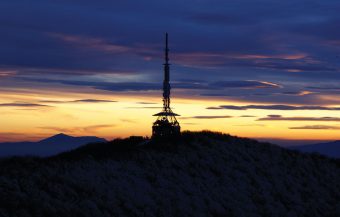Avala Tower is undoubtedly one of the most recognizable Belgrade landmarks. Its observation deck provides a spectacular view stretching from Šumadija to the Vršac Tower, and thanks to its telecommunications equipment, it broadcasts television and radio signals. The Avala Tower is our most important telecommunications facility, with the highest allowed transmitter power, broadcasting three digital television channels or TV program packages, five analog radio programs using FM technology, and one digital radio program package using DAB+ technology. Very few people know that the transmitters consume about 130 kWh continuously, while the entire tower complex consumes about 200 kWh, amounting to approximately 150,000 kWh per month. Through rational use and procurement of the latest equipment, efforts are made to achieve maximum electricity savings.

Procuring newer generation transmitters, which are significantly more efficient, is the first step in energy savings. For example, Avala Tower previously used older-generation TV transmitters with a 20-per cent efficiency. A few years ago, technologically advanced transmitters with a significantly higher efficiency of 42 per cent were acquired. Sava Savić, director of the Emisiona Tehnika i Veze public enterprise, explains that this has saved about 30,000 kWh monthly and reduced CO2 emissions by 12,000 kg. The same principle is applied to radio transmitters, and the replacement of older transmitters at Avala is planned soon.
“We save electricity by using air conditioning rationally and ordinary fans where possible. We have installed automation at nine transmission stations, which autonomously decides whether to turn on the air conditioning or the fan depending on the external and internal temperature. Analyzing the automation’s operation, we found that the air conditioning was on only 15 per cent of the time, while the fan operated 85 per cent of the time. We estimate that we have saved about 9,000 kWh per transmission station with the advanced automated ventilation and air conditioning system,” Savić explains. He emphasizes that reducing transmitter power during nighttime hours when viewership and listenership are very low can save much energy with minimal reduction in the service area.
IN FOCUS:
- Innovative Series of ABB Frequency Converters for Environmentally Sustainable Solar Water Pumping Systems
- Manasija Gets a Solar Power Plant
- Innovative Application of Information Technologies in Agriculture
Generators and Uninterrupted Power Supply
There is a system to ensure uninterrupted power supply at every important transmission facility, including Avala Tower. The system consists of uninterruptible power supply (UPS) devices and diesel generators of appropriate power. In the event of a power outage from the electrical grid, the UPS takes over broadcasting without interruption. The generator’s automation detects the power outage and starts the generator. After about 15 seconds, the generator achieves stable voltage and frequency parameters, and the power supply is switched to the generator.
UPS capacities are designed to handle the full load and power the equipment for about 10 minutes, which is more than enough since the generator takes over in less than a minute. The generator capacities are designed to be loaded within 40-70 per cent of their maximum power.
“At Avala, we have the latest generation Schneider Electric UPS, with appropriate power and capacity, and three generators, each with a 400 kVA power. All UPS devices and diesel generators are modernized and connected to the monitoring system,” adds Savić.
Digital broadcasting of TV and radio programs has undoubtedly brought enormous savings in electricity consumption and frequency usage as a limited resource.
Prepared by Milica Radičević
Read the whole interview in the new issue of the Energy portal Magazine AGROSOLAR ENERGY AND RES.



